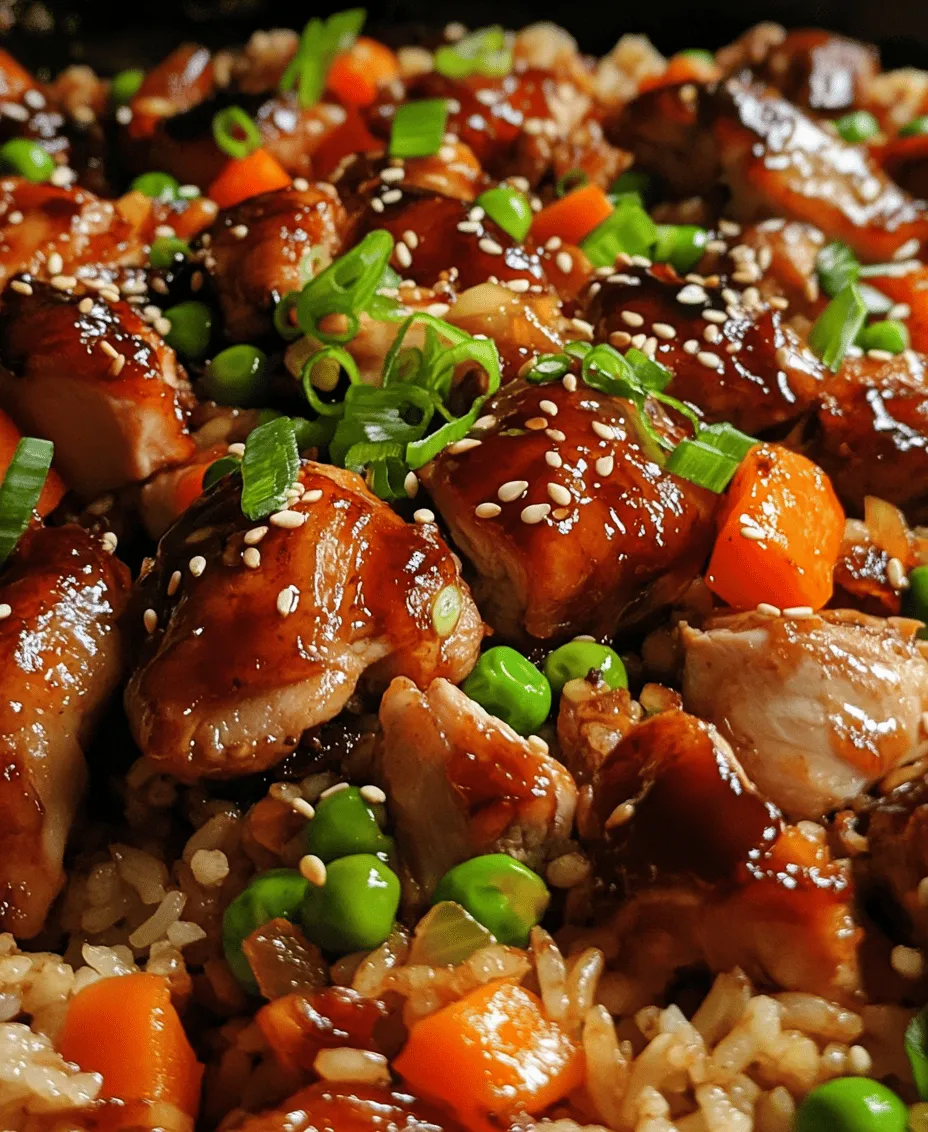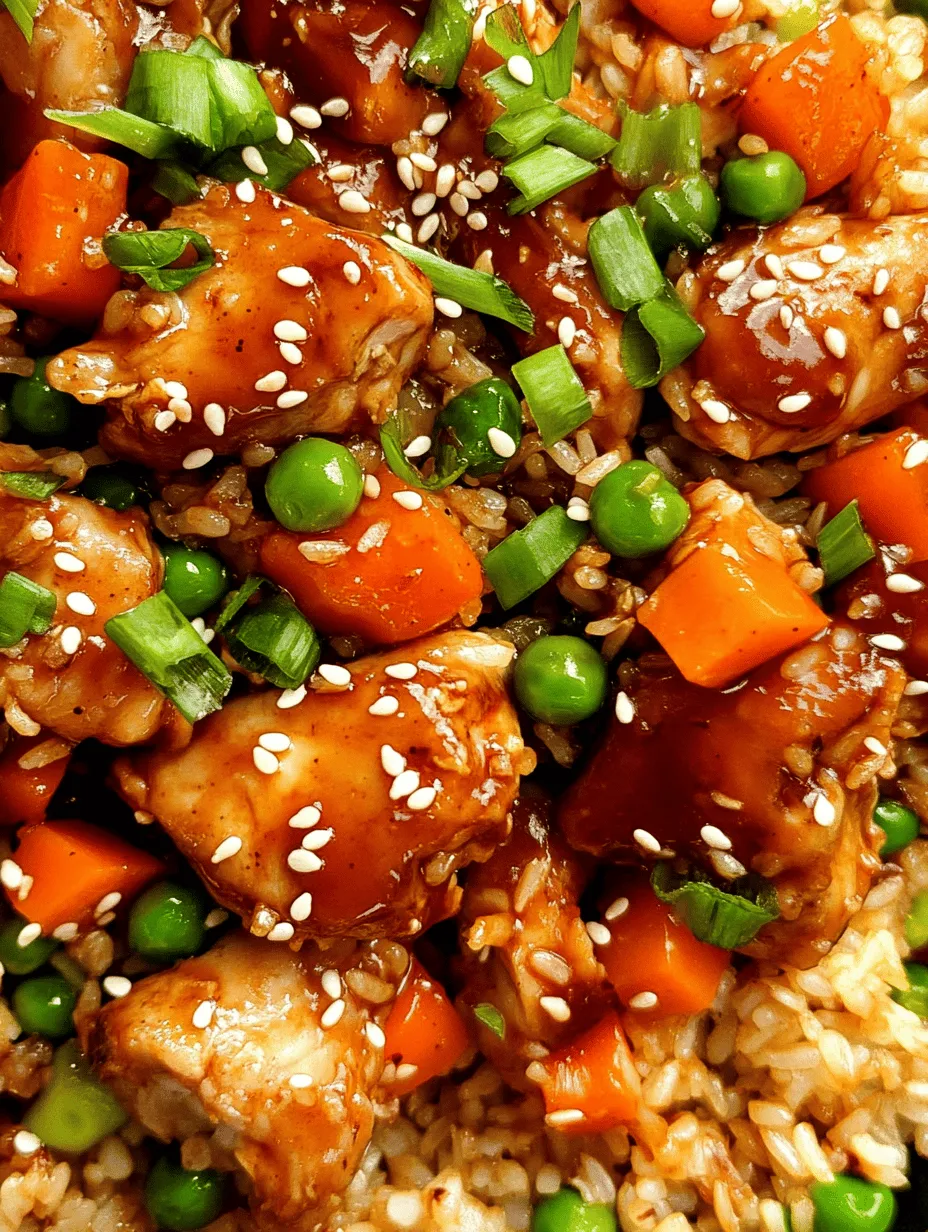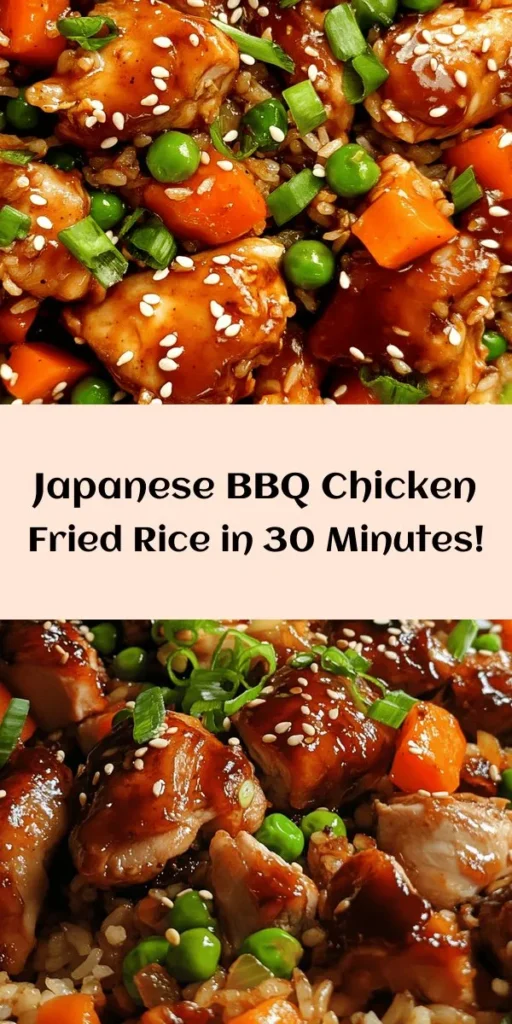Introduction
Fried rice is a beloved dish that transcends cultural boundaries, presenting a comforting yet versatile meal that is found in various forms across the globe. From the classic Chinese fried rice to the spicy Korean versions, this humble dish has earned its place as a staple in many households. However, what happens when we infuse the timeless comfort of fried rice with the rich, savory flavors of Japanese BBQ? The result is a truly delectable creation: Savory Japanese BBQ Chicken Fried Rice Extravaganza.
This dish marries the umami-rich elements of Japanese cuisine with the textural delight of perfectly cooked fried rice, creating a fusion that is both satisfying and exciting. The appeal of this recipe lies not only in its incredible flavor but also in its practicality. Utilizing day-old rice, which absorbs flavors better and has the right texture, makes this dish a go-to for leftover rice. It transforms simple ingredients into a culinary masterpiece that can be enjoyed as a quick weeknight dinner or a star dish for gatherings.
What makes this recipe unique is the combination of luscious chicken thighs marinated in aromatic Japanese BBQ sauces, the colorful crunch of fresh vegetables, and the richness of eggs, all brought together by the nutty fragrance of sesame oil. Each bite delivers a balance of savory, sweet, and slightly smoky flavors, making it a truly unforgettable experience. Join us on this flavorful journey as we explore the ingredients, preparation steps, and cooking techniques that will elevate your fried rice game to new heights.
Understanding the Ingredients
To create the Savory Japanese BBQ Chicken Fried Rice Extravaganza, it’s essential to understand the key ingredients that contribute to its distinctive flavor and texture. Each component plays a vital role, and knowing how to select and prepare them will ensure you achieve the best results.
Jasmine Rice
When it comes to fried rice, the type of rice you use is crucial. For this recipe, jasmine rice is the preferred choice due to its fragrant aroma and slightly sticky texture. One of the secrets to perfect fried rice lies in using day-old rice. Freshly cooked rice can be too moist and sticky, resulting in clumps rather than the desired fluffy texture. Day-old rice has had time to dry out slightly, making it ideal for frying. The grains remain separate, allowing them to absorb the flavors of the other ingredients without becoming mushy. Additionally, jasmine rice’s subtle floral notes complement the savory elements of the dish beautifully.
Chicken Thighs
While many recipes may call for chicken breasts, using chicken thighs is a game-changer in this dish. Chicken thighs are generally more flavorful and juicier than breasts, thanks to their higher fat content. This added richness enhances the overall taste of the fried rice, ensuring that each bite is succulent and satisfying. Furthermore, thighs are less prone to drying out during cooking, making them ideal for high-heat methods like stir-frying. When marinated in Japanese BBQ sauce, they absorb flavors exceptionally well, resulting in tender, flavorful pieces throughout the dish.
Japanese BBQ Sauces
The soul of this dish lies in the Japanese BBQ sauces, which add depth and complexity to the fried rice. Two popular types are Yakiniku sauce and Teriyaki sauce. Yakiniku sauce is typically savory with a hint of sweetness, often made from soy sauce, mirin, and a blend of spices. It pairs perfectly with grilled meats and brings a delightful umami flavor to the chicken. On the other hand, Teriyaki sauce is slightly sweeter and thicker, made with soy sauce, sake, and sugar. The caramelization of the sugars during cooking creates a beautiful glaze that enhances the overall presentation and flavor profile. Choosing the right sauce—or even a combination of both—can elevate your fried rice to an extraordinary level.
Vegetables
To balance the dish and add nutritional value, a variety of vegetables are included. Carrots, peas, and bell peppers not only contribute vibrant colors but also offer a range of textures and flavors. Carrots add a subtle sweetness and crunch, while peas provide little bursts of freshness. Bell peppers, whether red, yellow, or green, contribute a mild sweetness and a satisfying crunch that contrasts beautifully with the tender chicken and fluffy rice. Additionally, incorporating vegetables ensures that you have a well-rounded meal, making this dish not just tasty but nutritious as well.
Eggs
Incorporating eggs into fried rice is a time-honored tradition that adds richness and protein. Eggs serve as a binding agent, helping to bring the other ingredients together while also providing a creamy texture that enhances the overall mouthfeel of the dish. They can be scrambled into the rice or cooked separately and added at the end, depending on your preference. The key is to cook the eggs just right—soft and fluffy, without overcooking them, so they maintain their vibrant yellow color and creamy consistency.
Sesame Oil
Lastly, sesame oil is an essential ingredient that ties all the flavors together. This aromatic oil has a distinctive nutty flavor that enhances the overall taste of the fried rice. A drizzle of sesame oil at the end of cooking can elevate the dish to new heights, adding a layer of complexity and richness that is simply irresistible. Additionally, sesame oil can be used in the marinating process to infuse the chicken with its unique flavor, ensuring that every component of the dish is harmonized.
Preparation Steps for Success
Now that we’ve explored the key ingredients, let’s dive into the preparation process. Proper preparation is crucial to achieving the best results, and following these steps will set you up for success when making your Savory Japanese BBQ Chicken Fried Rice Extravaganza.
Ingredient Preparation
Before you begin cooking, it’s important to prepare all your ingredients properly. Start by rinsing the jasmine rice under cold water until the water runs clear. This step helps remove excess starch, preventing the rice from becoming gummy. After rinsing, cook the rice according to package instructions and allow it to cool completely. Ideally, use rice that has been refrigerated overnight for optimal texture.
Next, chop your vegetables. For the carrots and bell peppers, aim for uniform pieces to ensure even cooking. Small dice works well for carrots, while thin strips or small squares are perfect for bell peppers. If using frozen peas, there’s no need to thaw them beforehand, as they will cook quickly once added to the hot pan.
For the chicken thighs, trim any excess fat and cut them into bite-sized pieces. Marinating the chicken is a crucial step that enhances its flavor and tenderness. Prepare a marinade by combining your chosen Japanese BBQ sauce with a splash of sesame oil, garlic, and ginger if desired. Allow the chicken to marinate for at least 30 minutes, or up to several hours if time permits. This marination time allows the chicken to absorb the flavors deeply, resulting in a more delicious end product.
Cooking Techniques
When it comes to cooking fried rice, using a wok or a large skillet is highly recommended. The high sides of a wok allow for easy tossing and mixing of ingredients without spilling, while the flat bottom provides even heat distribution. If you don’t have a wok, a large cast-iron skillet works just as well.
Heat your cooking vessel over medium-high heat until it’s hot, then add a drizzle of sesame oil. The oil should shimmer but not smoke. This is the ideal time to add your marinated chicken thighs, allowing them to sear and develop a nice color. Proper heat management is key here; avoid overcrowding the pan, as this can lead to steaming rather than browning. Cook the chicken until it’s fully cooked through and caramelized, then transfer it to a plate to rest while you prepare the rest of the dish.
Cooking the Eggs
To incorporate eggs into your fried rice, crack them into a bowl and whisk until well combined. In the same wok or skillet, add a touch more sesame oil if needed and reduce the heat slightly. Pour in the eggs and allow them to sit for a few seconds. Using a spatula, gently scramble the eggs, pushing them from the edges toward the center of the pan. Timing is crucial here; you want the eggs to be soft and fluffy, so remove them from the heat just before they’re fully set. They will continue to cook from residual heat, ensuring they remain tender and creamy when mixed with the rice.
With the eggs cooked to perfection, you’re now ready to continue with the rest of the cooking process, which will bring all these wonderful flavors and textures together in an unforgettable dish.
Stay tuned for the next section, where we’ll delve deeper into the cooking process, providing you with a step-by-step breakdown that will guide you through creating your own Savory Japanese BBQ Chicken Fried Rice Extravaganza.

Sautéing the Chicken
Sautéing the chicken is a pivotal step in creating the perfect Savory Japanese BBQ Chicken Fried Rice. The key to achieving that beautiful caramelization lies in the technique. Begin by ensuring that your chicken pieces are evenly sized; this guarantees they cook uniformly. Use a high-quality, non-stick skillet or wok to prevent sticking and allow for easy flipping.
When you add the chicken to the skillet, resist the temptation to overcrowd the pan. Overcrowding traps steam, which can lead to steaming instead of searing. Instead, work in batches if necessary, allowing enough space for the chicken to sear nicely. An important note: let the chicken cook undisturbed for a couple of minutes before stirring. This undisturbed time allows the chicken to develop a golden-brown crust, enhancing both flavor and texture.
Cook the chicken until it is no longer pink in the center and the juices run clear, which usually takes about 5 to 7 minutes, depending on the size of the pieces. Once cooked, remove the chicken from the skillet and set it aside while you prepare the vegetables.
Vegetable Sautéing
Next up is the vegetable sautéing phase, which adds both nutrition and vibrant colors to your dish. Begin by adding a splash of oil to the skillet, allowing it to heat up until shimmering. This indicates that the pan is hot enough for sautéing.
When you add your vegetables—commonly bell peppers, peas, and carrots—keep in mind that the goal is to maintain their crunchiness and fresh flavor. Sauté the vegetables for about 2 to 4 minutes over medium-high heat, stirring frequently. The idea is to soften them slightly while still retaining some bite, which adds a delightful texture contrast in your fried rice.
For optimal flavor, consider adding minced garlic and ginger towards the end of the sautéing process. These aromatics infuse the dish with depth and complement the savory notes of the BBQ sauce you will be using later. Once the vegetables are tender yet crisp, it’s time to combine everything.
Combining Everything
Combining the sautéed chicken and vegetables with the rice is where the magic happens. Start by adding the cooked rice to the skillet with the vegetables. If you’re using refrigerated rice, ensure that it’s broken up so that it heats evenly.
Drizzle your favorite Japanese BBQ sauce over the rice, ensuring an even distribution. This is crucial for flavor integration. Use a spatula to fold the rice gently, mixing all ingredients without smashing the grains. The goal is to incorporate the chicken and vegetables throughout while ensuring that every grain of rice is coated in that savory sauce.
To elevate the dish, consider adding a splash of soy sauce or a sprinkle of sesame oil for an extra depth of flavor. After everything is well mixed, allow the fried rice to cook for an additional 2-3 minutes on high heat. This step helps to achieve a slightly crispy texture at the bottom, reminiscent of the delicious “socarrat” found in paella.
Serving Suggestions and Presentation
Once your Savory Japanese BBQ Chicken Fried Rice Extravaganza is ready, it’s time to think about presentation. A visually appealing dish enhances the overall dining experience. Serve the fried rice in a large bowl or individual plates, allowing the colorful ingredients to shine.
Garnishing Techniques
Garnishing is not just for aesthetics; it adds flavor as well. A sprinkle of toasted sesame seeds can provide a delightful crunch and nutty flavor, while fresh cilantro or green onions can brighten the dish. Consider adding thinly sliced radishes or a wedge of lime on the side for a refreshing contrast that can balance the richness of the fried rice.
Pairing Suggestions
To complement your fried rice, consider pairing it with a light side dish or beverage. A simple cucumber salad with a vinegar-based dressing can provide a refreshing palate cleanser. For beverages, a chilled Japanese beer or a light, fruity sake can enhance the meal experience. Alternatively, a cold green tea can provide a balanced accompaniment, especially during warmer months.
Nutritional Information
Understanding the nutritional benefits of your meal is essential, especially when preparing a dish like Savory Japanese BBQ Chicken Fried Rice. This dish is not only delicious but also offers a balanced array of nutrients.
Caloric Content
On average, a single serving of this fried rice contains approximately 500-600 calories, depending on portion size and specific ingredients used. This makes it a satisfying option for a main meal while still fitting within a balanced diet.
Protein and Fiber Content
The chicken in this recipe is an excellent source of protein, which is crucial for muscle repair and growth. A serving typically provides around 30 grams of protein, making it a hearty choice for those looking to increase their protein intake. The combination of vegetables contributes to the fiber content as well, which aids in digestion and helps maintain a healthy gut.
Culinary Variations and Adaptations
One of the beauties of fried rice is its adaptability. Here are some creative variations to consider:
Vegetarian/Vegan Options
For a vegetarian or vegan version, simply substitute the chicken with tofu or tempeh. Marinate the tofu in the same BBQ sauce for added flavor before sautéing. You can also increase the vegetable variety by adding mushrooms, zucchini, or snap peas, ensuring a colorful and nutrient-packed dish.
Spice Levels
If you enjoy a bit of heat, consider incorporating chili oil or red pepper flakes during the cooking process. Start with a small amount and adjust according to your preference. You could also serve the dish with a side of spicy kimchi for an authentic touch that complements the flavor profile of the fried rice.
Cultural Significance of Fried Rice
Fried rice holds a special place in various cultures, and in Japan, it is a beloved comfort food that reflects the adaptability and creativity of home cooking. Known as “chahan,” Japanese fried rice often incorporates leftover ingredients, making it an economical and resourceful meal.
In addition to its presence in Japanese cuisine, fried rice is celebrated in many cultures worldwide, from the Chinese Yangzhou fried rice to the Indonesian Nasi Goreng. Each variation represents regional flavors and cooking techniques, showcasing the universal love for this dish. Fried rice not only nourishes the body but also brings families together around the dinner table, reinforcing the idea of shared meals and hospitality.
Conclusion
The Savory Japanese BBQ Chicken Fried Rice Extravaganza is a delightful, easy-to-make dish that satisfies hunger while delivering a burst of diverse flavors. It embodies the spirit of home cooking—creative, comforting, and adaptable to your pantry’s offerings. This recipe encourages you to rekindle the joy of cooking at home and to experiment with flavors, making it a perfect addition to your culinary repertoire.
Whether you’re preparing a weeknight dinner or entertaining guests, this fried rice extravaganza promises to impress. So gather your ingredients, follow the steps, and enjoy the wonderful experience of creating a dish that not only fills your stomach but also warms your heart. Happy cooking!



